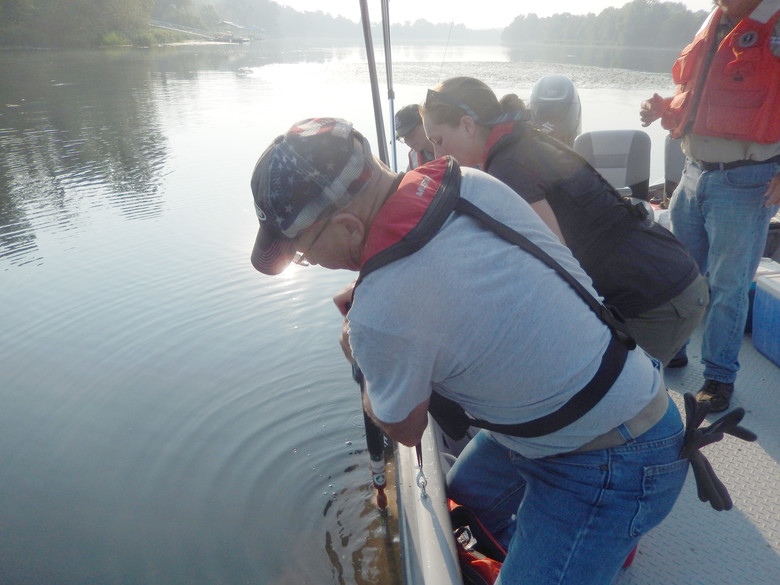
Geologists from the U.S. Army Corps of Engineers, Savannah District began collecting soil samples from the bottom of the Savannah River recently as part of a disposition study to determine the cost and benefit of removing an old underwater training wall in the Savannah River.
The one and a half mile-long training wall runs from just downstream of Eighth Street and ends 1,800 feet downstream of Boathouse Community Center in Augusta, Georgia. It aided commercial shipping in the early 20th century by keeping the navigation channel deep for the port in Augusta on the Georgia side of the river.
Although there’s no longer a port in Augusta, Corps Project Manager Joshua Nickel said the wall still performs as intended, which creates unwanted conditions today. That is, in keeping the Georgia side deep, the slower-moving water on the South Carolina side caused a buildup of sediment behind the wall over the years. This has gradually made the now-developed South Carolina side of the river shallower.
In its existing condition, Nickel says that the stone and pillared structure presents a safety hazard that impacts navigation and is a nuisance to recreational boaters.
“If we don’t do anything about it, the safety hazard remains,” said Nickel.
Nickel said that one of the potential outcomes of the study is a recommendation to remove the wall at full federal expense. If the study recommends removal of the training wall, the execution would require an appropriation from Congress to complete the work.
Because removal of the wall could also lead to removal of the built up sediment along the North Augusta side of the river, Nickel said the Corps is collecting and studying the soil to determine the best way to dispose of the sediments with the least impact to the environment. Clearing away the sediment behind the training wall would alleviate hazardous obstructions, deepen water levels, and potentially remove unsightly mudflats.
The collected soil samples, which came from select locations in the river behind the training wall, will be shipped to the Environmental Materials Unit and Environmental Monitoring and Technologies, Inc., to be analyzed for particle size and environmental conditions.
“The data obtained will help us evaluate environmental considerations for disposing of the sediment material,” said Corps geologist April Kelly. “We are investigating the sediment to determine its characteristics and also if contaminants are present. The analysis will help us answer questions like: Is it easily erodible? Is it consistent over the depth? Would it be easy to remove? The results will be an important factor in our design considerations for removal and disposal.”
Nickel said that the soil collection is only one component of the study and that the data obtained from the soil collection will also help the Corps to determine the cost estimate for removing the training wall.
“We are evaluating to determine the best course of action,” said Nickel. “Depending on results of our geotechnical data collection and archeological research, we will shape our conceptual design for removal.
The study is currently scheduled for completion in January 2020.


Chattooga Schools
GNTC student’s sculpture fuses love for welding, art

Chattooga Local News
U.S. Postal Service Provides Sneak Peek at 2025 Stamps

Chattooga Opinions
The Joy of the Journey: Living Life with an Attitude of Gratitude

Chattooga Schools
GNTC honors Electrical Lineworker graduates for fall 2024

Bulloch Public Safety
11/04/2024 Booking Report for Bulloch County

Bulloch Public Safety
10/21/2024 Booking Report for Bulloch County

Bulloch Public Safety
10/28/2024 Booking Report for Bulloch County

Bulloch Public Safety
11/07/2024 Booking Report for Bulloch County

Bulloch Public Safety
10/29/2024 Booking Report for Bulloch County




